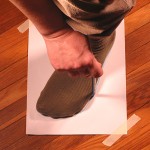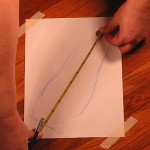 Last spring, we were packing for a six week trip to Europe. Three days before the trip, our son announced that is shoes felt tight. Since a shoe shopping trip was not in the cards, I hopped on the internet to buy new shoes. (thank heavens for Amazon Prime with free 2-day shipping!) Not knowing whether he’d gone up 1/2 size or a 1 1/2 sizes, this handy little sizing demo from About.com saved the day.
Last spring, we were packing for a six week trip to Europe. Three days before the trip, our son announced that is shoes felt tight. Since a shoe shopping trip was not in the cards, I hopped on the internet to buy new shoes. (thank heavens for Amazon Prime with free 2-day shipping!) Not knowing whether he’d gone up 1/2 size or a 1 1/2 sizes, this handy little sizing demo from About.com saved the day.

Gather your supplies
All you need to get your child’s proper foot measurement at home is:
- a piece of paper larger than your foot
- a pencil
- tape
- a ruler or measuring tape.
 Tracing your child’s foot to find shoe size
Tracing your child’s foot to find shoe size
Tape the paper to the floor.
Have your child stand with his foot firmly on the paper, and leg bent slightly forward so that the shin is slightly in front of the ankle.
Trace the outline of his foot and remember to measure without shoes, but with socks similar to the ones he’ll be wearing with the shoes you are buying.
Hold the pencil or pen upright and perpendicular to the paper. Do not hold it at an angle. Make sure the pencil is resting snugly against the foot as you draw around it.
 Mark the length and width of your child’s foot
Mark the length and width of your child’s foot
Use your pencil to draw straight lines touching the outermost points at the top, bottom, and both sides of the outline.
.
.
.
 Measure the length of your child’s foot
Measure the length of your child’s foot
Use your ruler or measuring tape to measure the length from the bottom line to the top line that you drew in step three.
Be sure to hold the measuring tape straight, and find the closest mark that you can (for inches, use the closest 16th mark) – don’t round up or down dramatically.
Write this number down.
Finding your final shoe size
Repeat these steps for your child’s other foot, and use the larger of the two.
After you have your numbers written down, you’ll want to subtract 3/16 of an inch from the numbers. This is to accommodate for the slight space between the actual foot and the line made by the pencil.
These final numbers are your child’s actual foot measurements, you can convert them to the appropriate size using the links below.
Boys and Girls Conversion Chart
| Inches | US / Canada | Europe | Japan | UK |
| 5.38 | 6.5 | 23 | – | 5.5 |
| 5.56 | 7 | 23.5 | 14 | 6 |
| 5.75 | 7.5 | 24 | – | 6.5 |
| 5.88 | 8 | 24.5 | 15 | 7 |
| 6.06 | 8.5 | 25 | – | 7.5 |
| 6.25 | 9 | 25.5 | 16 | 8 |
| 6.38 | 9.5 | 26 | – | 8.5 |
| 6.47 | 10 | 26.5 | 16.5 | 9 |
| 6.67 | 10.5 | 27 | – | 9.5 |
| 6.83 | 11 | 27.5 | 17.5 | 10 |
| 6.98 | 11.5 | 28 | – | 10.5 |
| 7.14 | 12 | 28.5 | 18.5 | 11 |
| 7.30 | 12.5 | 29 | – | 11.5 |
| 7.46 | 13 | 30 | 19 | 12 |
| 7.77 | 1 | 31 | 20 | 13 |
| 7.93 | 1.5 | 31.5 | 20.5 | 13 |
| 8.09 | 2 | 32.5 | 21 | 1 |
| 8.25 | 2.5 | 33 | 21.5 | 1.5 |
| 8.40 | 3 | 33.5 | 22 | 2 |

This could come in handy. Thanks for sharing!
whoah this blog is great i like studying your posts.
Keep up the good work! You recognize, many persons are hunting around for
this information, you could aid them greatly.